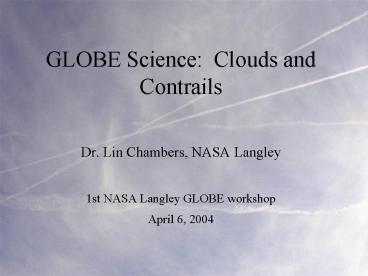GLOBE Science: Clouds and Contrails - PowerPoint PPT Presentation
1 / 22
Title:
GLOBE Science: Clouds and Contrails
Description:
Obtain contrail (and other cloud) information from the largest possible network ... Contrail is a shortened name for condensation trails. ... – PowerPoint PPT presentation
Number of Views:72
Avg rating:3.0/5.0
Title: GLOBE Science: Clouds and Contrails
1
GLOBE Science Clouds and Contrails
- Dr. Lin Chambers, NASA Langley
- 1st NASA Langley GLOBE workshop
- April 6, 2004
2
Objectives
- Obtain contrail (and other cloud) information
from the largest possible network of ground
observers - Use to
- Validate satellite retrieval algorithms
- Improve contrail prediction methods
3
Global Cloud CoverAugust 26, 1993
4
Do Humans Affect Cloud Cover?
5
(No Transcript)
6
(No Transcript)
7
Derived Product Requires Cloud Detection and
Cloud Property Retrieval
8
What are Contrails?
- Contrails are CLOUDS that form in the wake of
aircraft. - Contrail is a shortened name for condensation
trails. - Also known as vapor trails, jet trails,
chemtrails
9
Contrails have been around for a long time!
- They were first described in the scientific
literature in 1919. - During WWII, contrails sometimes littered the
skies during aerial combat.
10
Making A Cloud
Clouds form when water vapor condenses into
visible water droplets or ice crystals.
- Condensation can occur in two ways
- Increase the water content in the air.
- Cool the air to reach the dew point.
- Nearly all contrails form by mixing of a colder,
drier atmosphere with warmer, wetter jet exhaust
(mixing cloud).
11
Mixing clouds
- Mixing clouds form because the ability of air to
hold water vapor increases rapidly with
temperature. - Like contrails, the cloud that forms on your
breath during a cold day is a mixing cloud.
12
Why Do We Study Contrails?
When the upper atmosphere is moist enough, the
contrails continue to grow. Under
these conditions, the contrails become persistent.
13
Persistent contrails occasionally cover large
areas. Like cirrus clouds, contrails likely
contribute to global warming.
We currently estimate that contrails add an
additional 0.5 to 5 percent warming to the
greenhouse gas effect.
14
Air traffic and persistent contrail coverage will
continue to increase.
15
By 2050, the warming due to contrails may be
2.5 to 25 percent of the current greenhouse gas
warming.
16
GLOBE and Contrails
17
Data Sheet
18
Our estimates of the climatic effects of
persistent contrails are still uncertain. We
still have trouble estimating contrail coverage.
19
Most contrails are still smaller than the
resolution of most satellites.
20
Using inventories of commercial aircraft flight
data and satellite data, we are learning more
about the growth and coverage of contrails under
different atmospheric conditions. Surface
observations from GLOBE would improve our studies.
21
Inverse contrails (distrails)
Aircraft sometimes make holes in clouds!
22
Cloud/Contrail Protocol Summary
- No cost
- No equipment
- Simple
- Website http//asd-www.larc.nasa.gov/GLOBE
- Do any time
- Takes 5-10 minutes
- WE WANT YOUR DATA!!!































